This post may contain affiliate links. Please read our disclosure policy.
This vegan blue cheese is simply mind-blowing! Naturally cultured and prepared with just 5 ingredients, it makes use of traditional cheese-making techniques. The result is a sharp, creamy, and rich vegan blue cheese like you have never tried before!
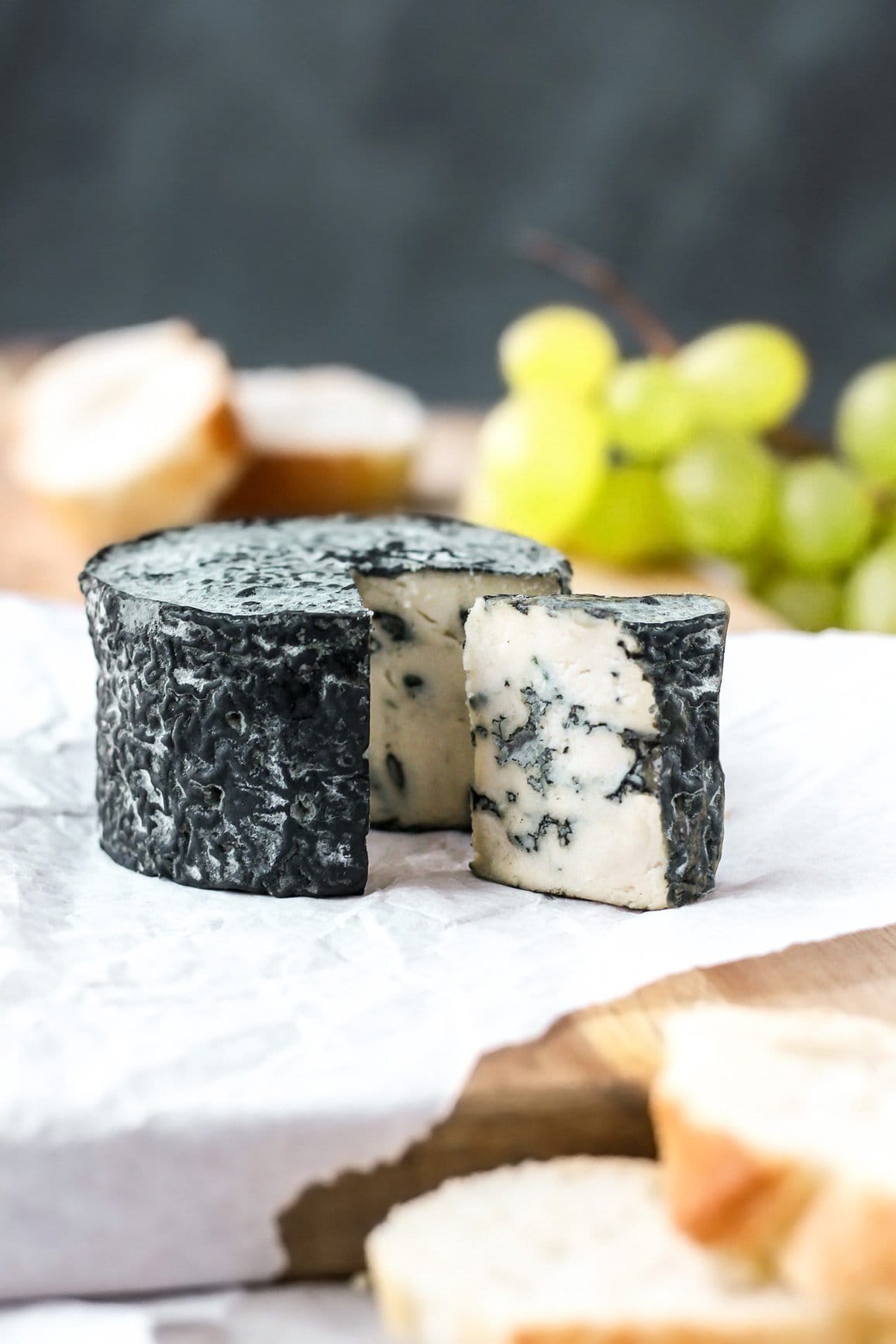
IT IS HERE. The vegan blue cheese recipe is finally here, friends!
I’m really, really excited about this recipe. First, because I have been working on it for several months, and second, because it tastes exactly like dairy cheese!
Shortly after releasing my vegan camembert recipe, I started to work on making a vegan blue cheese. Let me tell you, it was not an easy task! The real struggle was to get the blue veins – the essence of blue cheese. I first tried pricking the cheese like they usually do on the dairy ones, but the result was not as I expected. Although it was not a complete failure, it didn’t have prominent blue veins and lacked sharpness.
See, the blue mold, responsible for the pungent aroma of blue cheese, needs air to grow. Traditionally, the process consists of draining curds before transferring them to molds and allowing them to drain. The curds are not pressed, allowing for some holes inside the cheese. Those holes allow the blue mold to grow, creating veins inside the cheese. Unfortunately, this is not possible with cashew cream as it cannot be drained into curds.
Fast forward several months later and tens of tests, I finally found a way to create those beautiful blue veins. Eureka! One day, an idea came to mind. What if I age the cheese for a few weeks to make it slightly dryer, scramble it, and reassemble it while leaving some small holes inside? Well, it worked beautifully! As you can see in the photos on this page, my vegan blue cheese has plenty of nice blue veins, and I have to admit that I’m pretty proud to have developed this technique!
⭐️ Why You Should Try It
Blue cheese finally made vegan!
You read it right! To my knowledge (and I’ve looked around a lot), this is the first vegan blue cheese made with real cultures and a traditional aging process! This results in an appearance and taste that is simply unmatched.
Perfect texture with a rich and intense aroma.
My blue cheese is so creamy that you can spread it easily on a slice of bread but firm enough to cut it into slices. Plus, it has those natural blue veins that are so characteristic of this type of cheese.
When it comes to the taste, it’s everything you would expect from a blue cheese. It’s salty, slightly earthy, and has sharp, almost spicy notes. I served this cheese to non-vegans, and they could not believe it was not “real” blue cheese!
It’s a fun experiment.
Whether you are new to vegan cheese making or made some before, the process of making this blue cheese is interesting and exciting at the same time. You will see the mold slowly grow over a few weeks, and the flavors develop!
Readers love it.
With over 250 ★★★★★ ratings, this recipe is a must-try! Here is what some readers have to say about it:
Helen said: “My diet is 100% plant-based, and I’ve been making Thomas’ Blue Vein, Camembert, and Hickory Smoked Cheeses for a couple of years now. The blue vein is truly delicious – creamy and bitey at the same time. My latest batch is ready to be eaten now, and it takes every bit of willpower I have to stop myself from eating too much of it at once.”
James said: “Just tasted my first batch of this. It is, quite simply, the best vegan cheese I have ever made. All thanks to you Thomas – another epic recipe.”
Joseph said: “Kudos to you for creating this recipe. I’ve been missing a piece of blue since I converted to veganism about 40+ years ago. Now, thanks to you, I am eating blue cheese nearly every day. A second batch is being prepared.”
📘 What Is Blue Cheese
Blue cheese is a type of semi-soft cheese that is made with Penicillium Roqueforti cultures. This edible mold not only creates a sharp and piquant flavor, but it is also responsible for the blue/green veins inside and outside the cheese.
Historians say that Gorgonzola is one of the oldest types of blue cheese, appearing around AD 879.
🥛 Ingredient Notes
Cashews
Just like my other cheese recipes, I use raw cashews as a base. They bring the perfect amount of creaminess and richness. On top of that, mold grows very well on cashew-based cheeses.
Note: It’s crucial that you use raw cashews, not the roasted kind.
Starter culture
You will need a starter culture to trigger the fermentation process and give your cheese its tangy flavor. This type of culture is different from the ripening culture as it’s only responsible for the tanginess, not the blue veins/flavor.
Which culture to pick: I recommend using either Acidophilus or Mesophilic. You can get Acidophilus capsules online or at most pharmacies. The ones I use are Advanced Acidophilus Plus from the brand Solgar, which contains 500M microorganisms per capsule.
Regarding the Mesophilic, it’s a type of culture specifically made for cheese-making. Hence, you will only be able to find it in cheese-making supply stores or online.
To conclude, both work great, but I personally prefer using Mesophilic as it yields a superior, more buttery flavor.
Ripening culture
The ripening culture I use to allow the cheese to develop blue veins is a mold called Penicillium Roqueforti. It’s typically used on cheeses such as Roquefort, Gorgonzola, Stilton, etc.
Where to buy it: You can buy Penicillium Roqueforti online or in most cheese-making supply stores. It’s usually sold in a powdered or liquid form. Although it might seem a little bit expensive, a little goes a long way. For 4 pieces of cheese, you will only need about 1/8 tsp.
How to store it: You can store Penicillium Roqueforti in the freezer for several months. If it’s in liquid form, thaw for 15-20 minutes on the counter before using.
Coconut oil
Coconut oil adds creaminess and helps the cheese stay slightly firmer when chilled. I recommend using deodorized coconut oil so it doesn’t impart any coconut flavor to your cheese.
Note: Coconut oil is optional, and this recipe will still work without it.
Salt
Salt not only enhances the flavor but also prevents bad mold from growing.
🥣 How to Make It
The recipe is actually pretty easy to make. The hardest part is to be patient since the whole process will take you over a month.
1. Prepare the cashew cream
- Soak the cashews. Start by soaking the cashews in water for at least 5 hours or preferably overnight.
- Kill bacteria. Drain the cashews and place them in a large glass bowl. Bring a large pot of water to a boil. Once boiling, pour the water directly onto the cashews. Let sit for 1-2 minutes, and drain the cashews again. This step will help kill possible bacteria and prevent bad mold from growing. After draining, allow the cashews to cool down for about 30 minutes.
- Blend into a cream. Transfer the cashews to the bowl of a high-speed blender or food processor. Add the coconut oil and 5 tablespoons of filtered water. Blend on high speed, scraping down the sides from time to time until it forms a smooth and thick cream. This step might take about 10 minutes, depending on your blender.
- Add the cultures. If using Acidophilus, open the probiotic capsules and add the powder to the blender. Otherwise, add the mesophilic powder to the blender. Next, add the Penicillium Roqueforti and blend for another 10-15 seconds.
Note: The cashew cream should be smooth but quite thick. If needed, add 1 tablespoon of water at a time until smooth. Do not add too much water, otherwise the mixture will be too liquid.
- Transfer to a bowl. Transfer the cashew cream to a clean bowl and cover it with plastic film, touching the top of the cashew cream (this will prevent the top from drying). Let sit at room temperature in a dark place for about 24h-48h. This step will kick start the fermentation process, giving the cheese its tangy flavor.
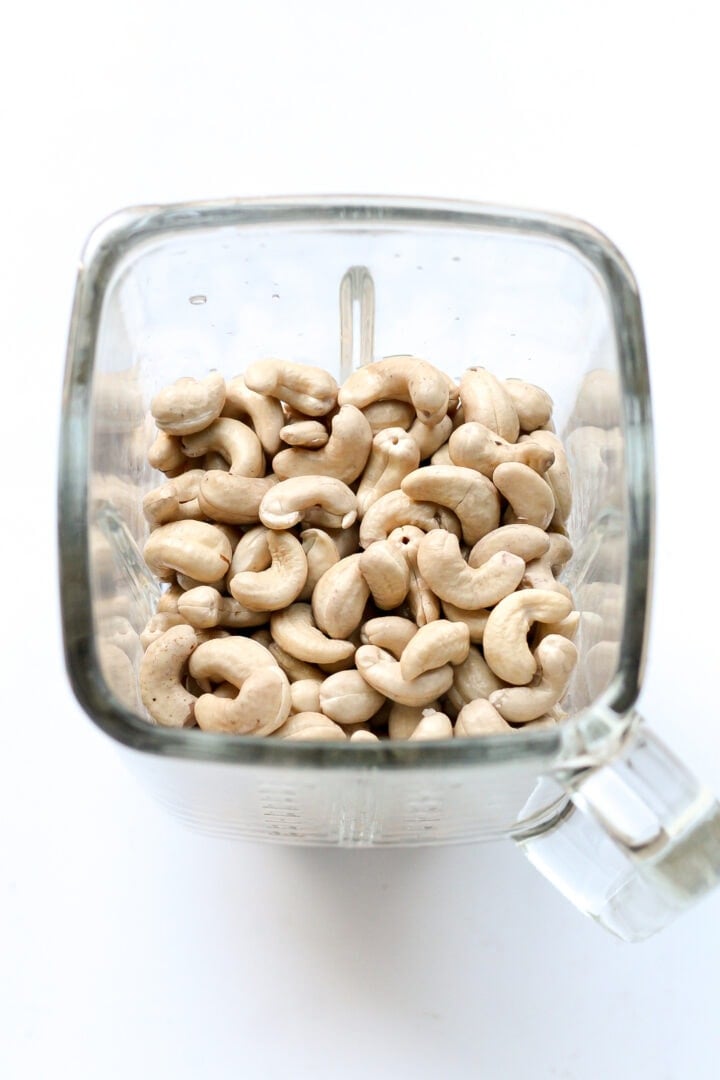
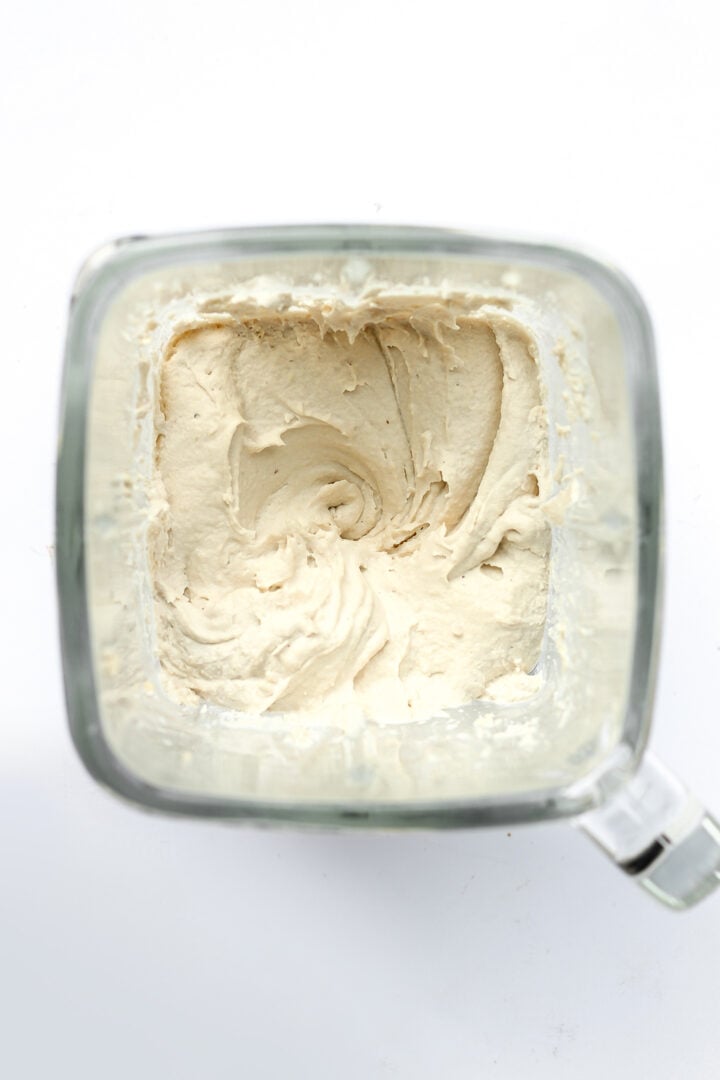
2. Shape the cheeses
Once your cashew cream has a tangy smell and taste, it’s time to shape it into wheels!
Note: Before starting, I just want to let you know that you do not have to use the exact pastry rings I recommend below. Any size or shape will work so feel free to use what you have on hand.
- Refrigerate the cashew cream. Place the bowl containing the cashew cream in the refrigerator for about 4 hours. This will make the mixture easier to work with.
- Prepare a container. Line the bottom of a food storage container with parchment paper. I use a 12×8 inches (30x20cm) one but any container with a similar size will work. This type of container, for example, works great.
- Line pastry rings. Place four 3×1.75 inches (7.5×4.5cm) pastry rings inside the container. Cut strips of parchment paper measuring 9.5×1.75 inches (24×4.5cm) and arrange them inside the pastry rings to cover the inside sides. Alternatively, you can use plastic film if you prefer. The goal is to prevent the cashew cream from touching the metal.
- Shape the cheeses. Fill each pastry ring to the top with the cashew mixture. Cover the tops with plastic wrap.
- Refrigerate. Close the container and transfer it to the refrigerator. Refrigerate overnight.
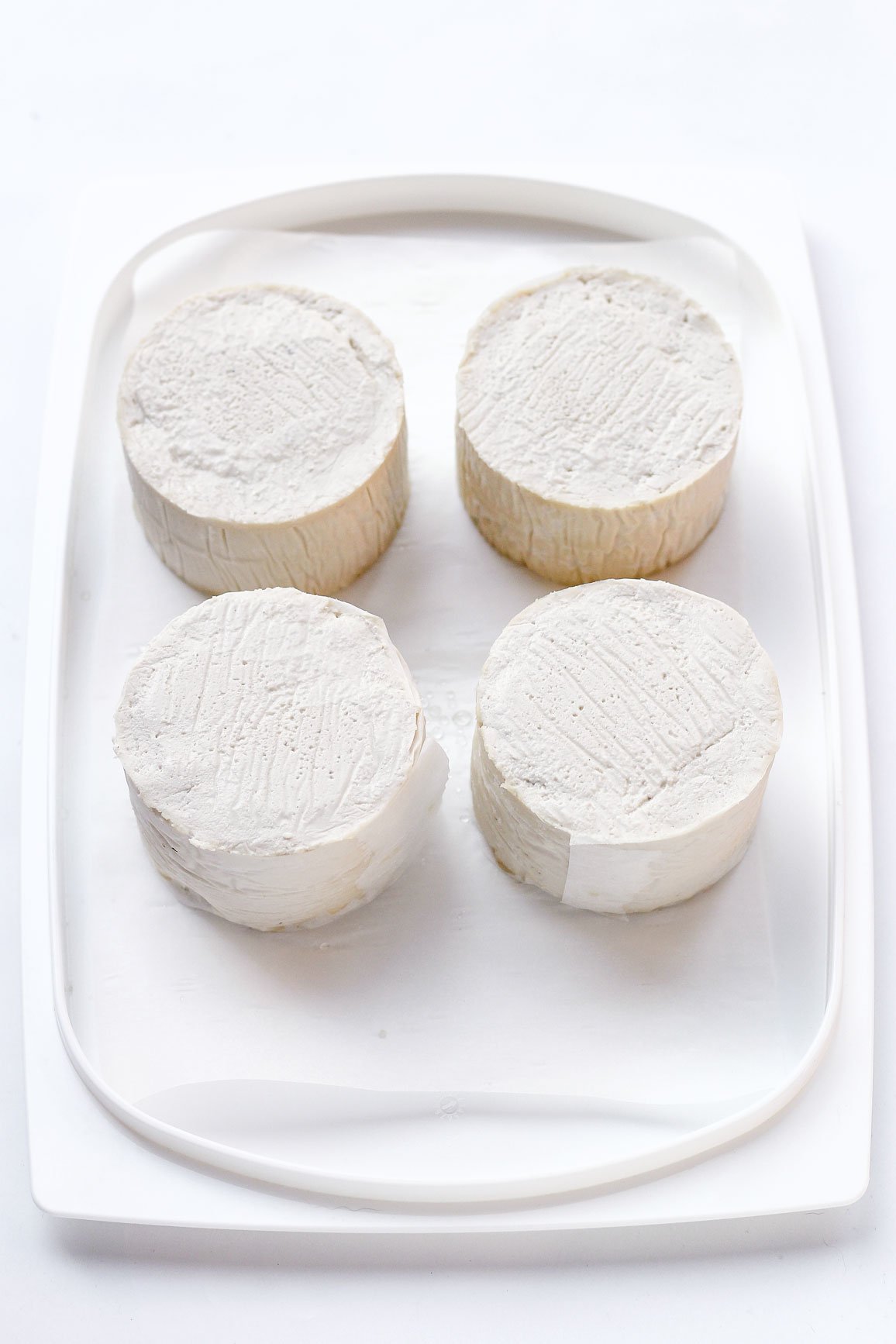
3. Salt the cheeses
The next day, it’s time to remove the cheeses from the pans and salt them. Salt will help with mold growth, so it’s essential.
- Sprinkle salt. The next day, remove the container from the refrigerator. Remove the plastic wrap from the top of the wheels. Sprinkle about 1/4 teaspoon of salt over the top of each wheel. Lightly rub the salt with clean hands to distribute it evenly.
- Flip the wheels. Carefully flip the wheels using a small plate lined with parchment paper. Transfer the wheels back to the container, non-salted side up. Sprinkle another 1/4 teaspoon of salt over the other side of the wheels. Rub some salt on the sides of each wheel as well. Note: The cheeses will still be very soft. This is normal. In a few days, they will firm up and be easier to work with.
4. Age the cheeses
- Refrigerate. Close the container and transfer it to the refrigerator or to a room or cheese cave with a temperature of about 47-52°F (8-11°C). Note: You can age your cheeses at a slightly colder temperature, but the mold will take longer to grow.
- Flip. Every day, carefully flip the cheeses. I recommend using very clean hands or working with gloves (or plastic wrap) to make sure you are not touching the cheeses.
- See the blue mold grow. After 7-10 days, you should start to see some light blue/green mold spots – it’s a good sign! Continue the flipping process for another 7 days. Remember that the mold will be slightly darker or lighter depending on the humidity and temperature of your fridge.
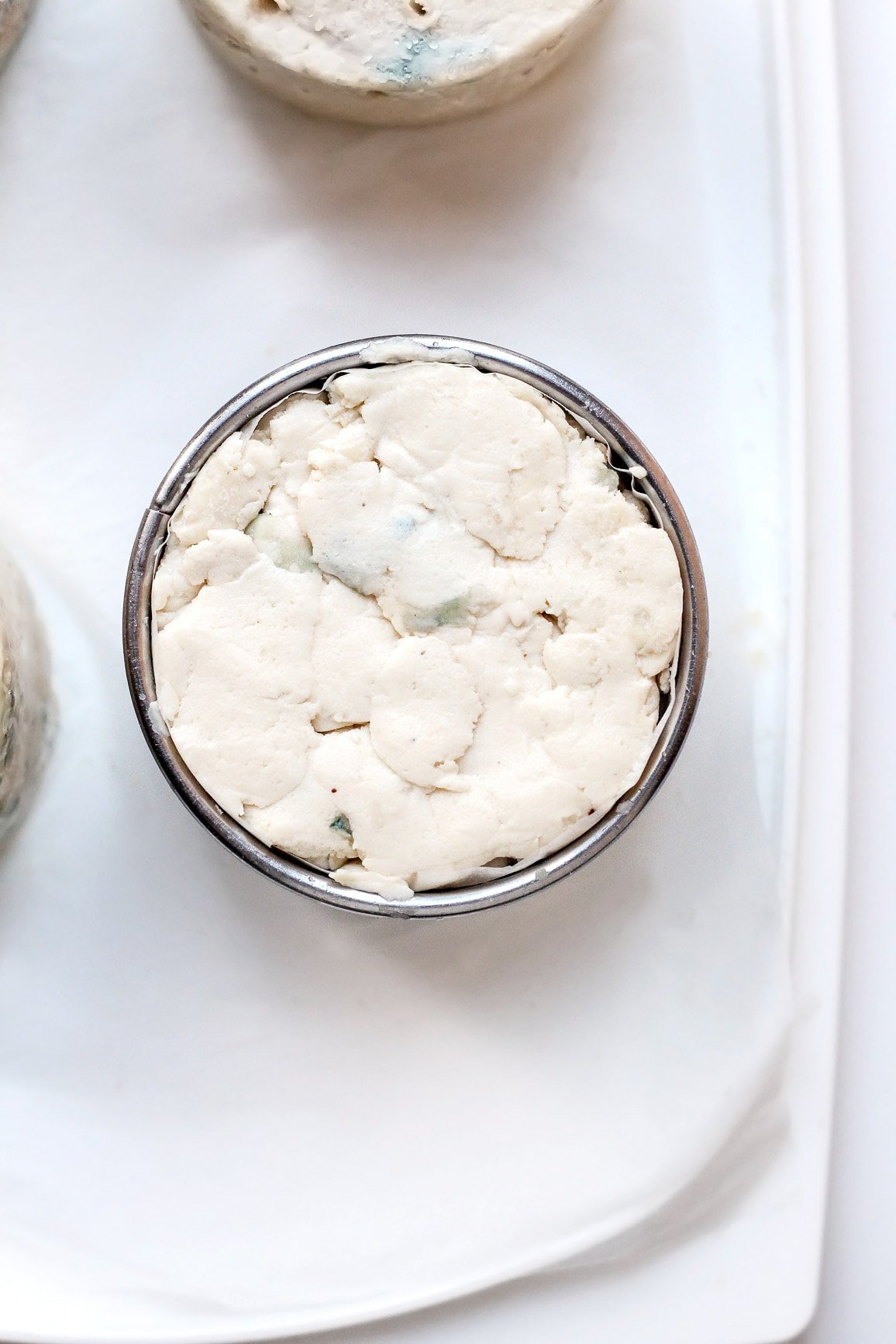
5. Crumble and re-shape
After a total of 14 days, your cheeses should be a bit firmer and almost completely covered with blue mold! It’s now time to crumble them to create the veins.
Why crumble the cheeses?
It’s the blue mold that gives the cheese its characteristic flavor. The problem is that the mold needs to be in contact with the air to grow, so you need to have many small openings inside the cheese for better mold growth. Regular blue cheeses are often pierced several times with a skewer to make holes. I tried this way but with no success. After several tries, I thought of scrambling the cheese into little pieces and then forming it again without pressing too much to leave large holes inside it. It worked!
- Scramble the cheeses. Using disposable gloves or very clean hands, scramble your cheeses (just like when you scramble tofu) into little pieces of about 1 inch (2.5cm) and transfer them to a clean bowl. The cashew mixture will still be quite soft, it’s normal.
- Re-shape them. Just like you did the first time, place four pastry rings inside a container and line them with parchment paper. Next, fill each pastry ring with the scrambled cheese without pressing too much to leave large holes on the inside. This step is essential to create a nice veining inside the cheese as the mold needs to be in contact with air to grow. You can remove the pastry rings right after shaping the wheels. Place the container back in your refrigerator or aging room.
- Flip. Continue to flip the cheeses every day for the next 3 weeks, always using clean hands or gloves. That’s fine if you miss a day or two.
- Wrap the cheeses. After a total of 5 weeks, the inside and the outside of your cheeses will be covered with blue mold. They will be ready to eat soon! Wrap each cheese in cheese paper or aluminum foil and wait another 3-7 days. The longer you let them age in the refrigerator, the stronger the taste!
📔 Tips
Age the cheeses in a container during the whole aging process.
Mold needs humidity to grow. That’s why you need to keep the cheeses in a small box or container in your refrigerator. If you were to let the cheeses uncovered, they would dry out before the mold gets a chance to grow.
Do not omit any ingredient.
This recipe is not versatile, so I do not recommend substituting or omitting any ingredient.
Use disposable gloves.
By using gloves each time you handle the cheeses, you reduce your chances of seeing bad mold growing. Disposable gloves are pretty cheap and come in large boxes, so do not hesitate to get yourself a box.
If you are making vegan camembert at the same time:
I recommend you keep them in two separate boxes. Mold can transfer very easily, and you could end up with white mold on your blue cheese or blue mold on your camembert.
Regarding the appearance of the cheese.
The rind of this blue cheese is dark blue because I didn’t scrape the sides. Be aware the rind is edible, but if you prefer the exterior to be white, you can gently scrape the mold using a clean knife every two weeks. I prefer to leave the rind because it looks cooler, and after about a month, it will become a little bit firmer. Creamy inside + firm rind = perfect cheese to me.
🥖 What to Serve It With
My favorite way to enjoy this blue cheese is with a fresh baguette! You can also serve it on a vegan cheese platter alongside vegan camembert, onion chutney, and grapes.
Crumbled, it makes a great topping to potato leek soup or butternut squash soup. You can even use it to make a delicious blue cheese dressing!

❄️ Storing and Freezing
- To store: You can store this cheese for about 1 month in the refrigerator. It will become firmer and sharper.
- To freeze: Wrap the cheeses in plastic wrap and freeze for up to 3 months. Thaw overnight in the refrigerator.
💬 FAQ
Yes, Penicillium Roqueforti is completely safe to eat!
It’s very easy to tell if a cheese has gone bad: just smell it. If it smells like rotten eggs, you should trash it. If there is some pink or black fuzzy mold, it’s not good either.
Roquefort is a type of blue cheese that is only produced in a specific area of France. It is a protected designation of origin.
No, this vegan blue cheese does not melt. It will only become softer once heated.
No, it won’t work. Yogurt starter is a thermophilic bacteria that works best at warmer temperatures (above 30°C or 90°F) as opposed to mesophilic bacteria that works at lower temperatures.
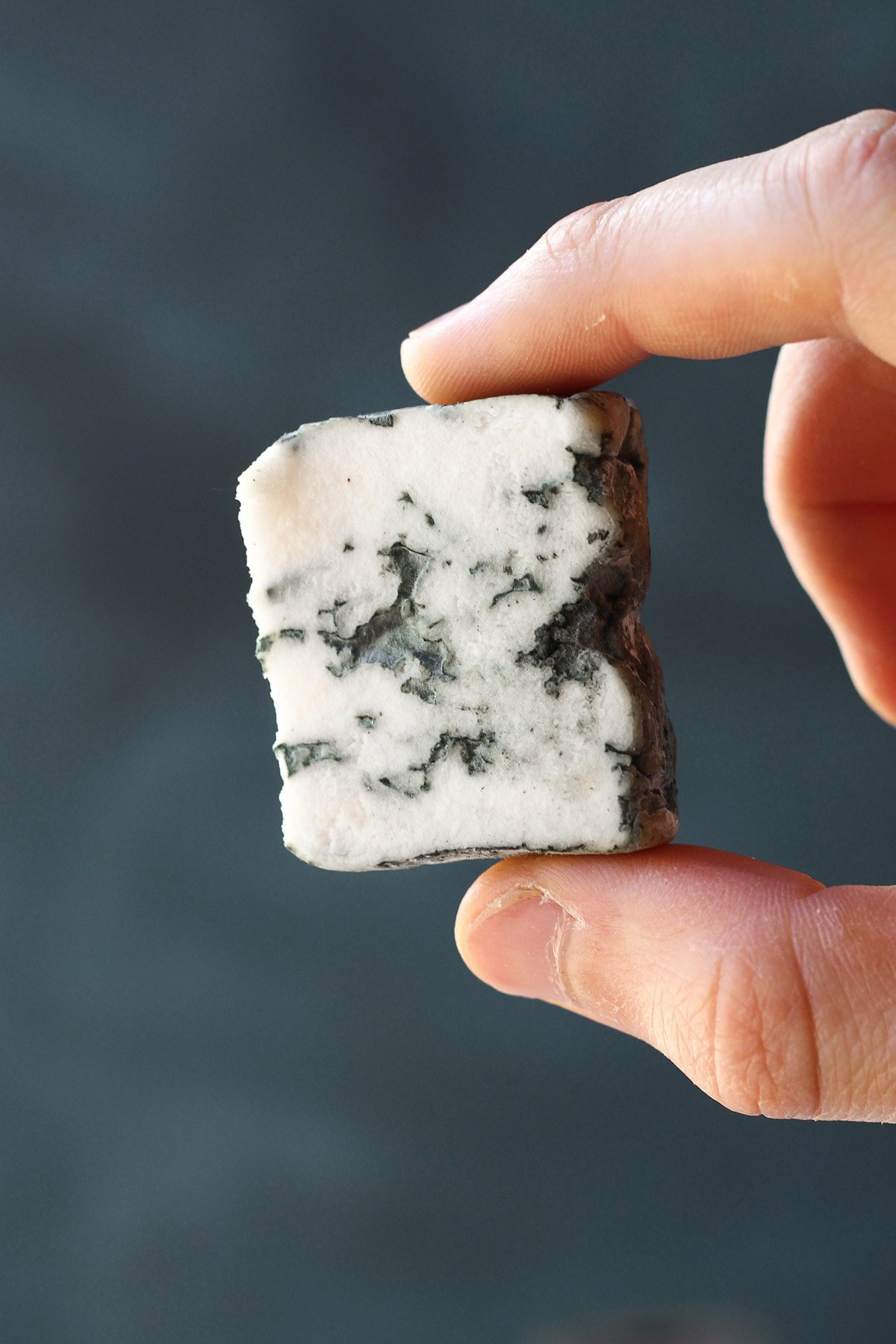
Disclaimer
- Links: The links I provide on this page for Penicillium Roqueforti may not redirect to a fully vegan product, as Amazon sellers change product references frequently. Just for your information, non-vegan cultures are grown on lactose, meaning they contain *traces* of lactose. Considering the amount used, you could still consider your cheese 99,99% vegan if you use a non-vegan culture. It’s up to you to choose which one fits your beliefs best. One more thing: fully vegan Penicillium Roqueforti exists, but you will have to do your own research to locate it.
- Credit: Many people have been making this cheese without giving any credit back and labeling it as their own. I worked really hard to create this recipe from scratch and had to do a ton of experiments before releasing it, so please give credit by tagging @fullofplants on Instagram or linking to this website.
I hope this recipe will prove to you that it’s possible to make everything with plant-based ingredients. If you are not vegan yet, you don’t have to give up on cheese anymore!
Please let me know if you try this recipe, and feel free to ask if you have any questions about the process!
🧀 More Vegan Cheese Recipes
⭐️ Did you like this recipe? Let us know in the comments below, and tag us on Facebook, Instagram, or Pinterest!
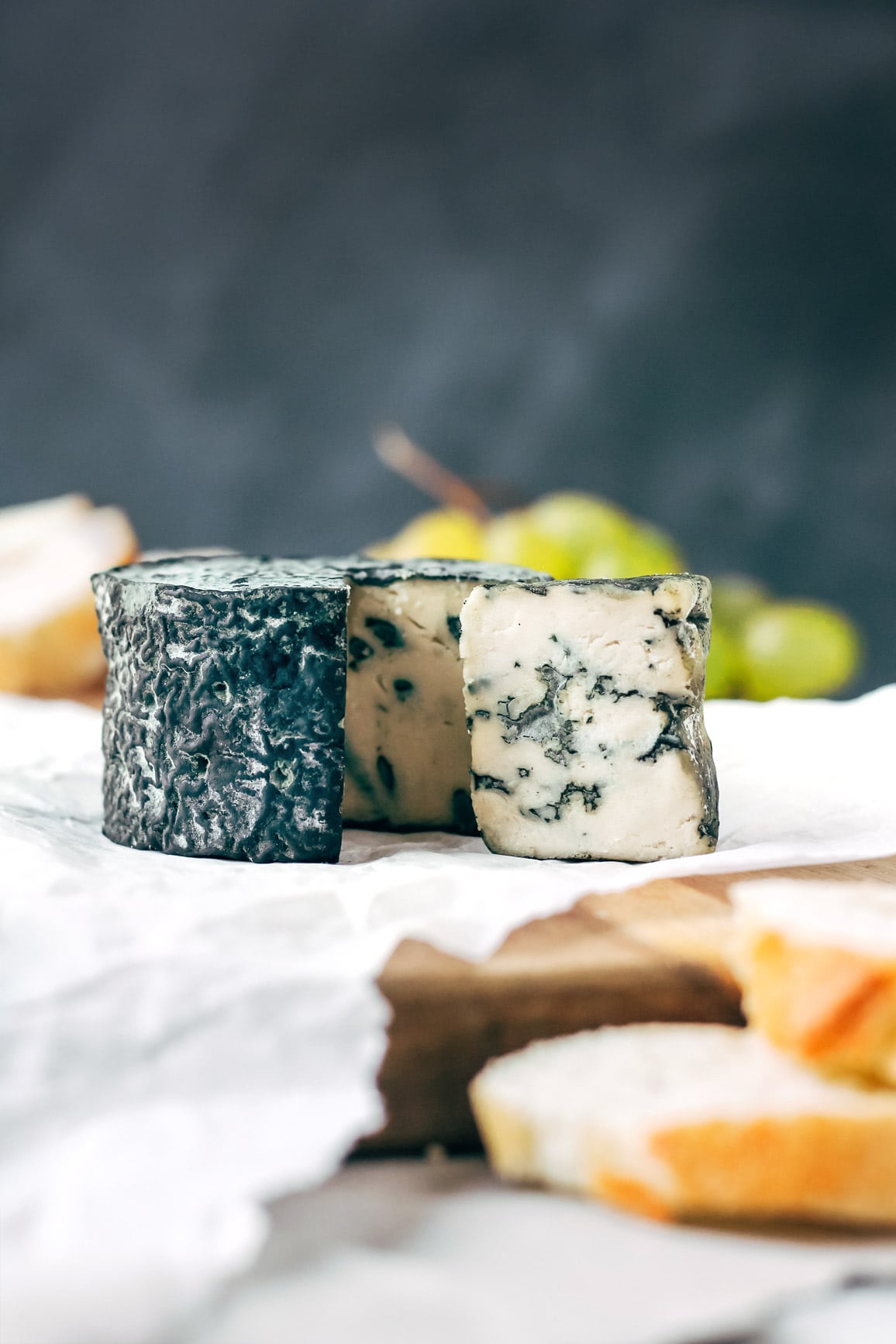

Want to Save This Recipe?
Enter your email below & we’ll send it straight to your inbox! Plus, you will receive new recipes every week!
I’d like to receive more tips & recipes from Full of Plants.
This site is protected by reCAPTCHA and the Google Privacy Policy and Terms of Service apply.
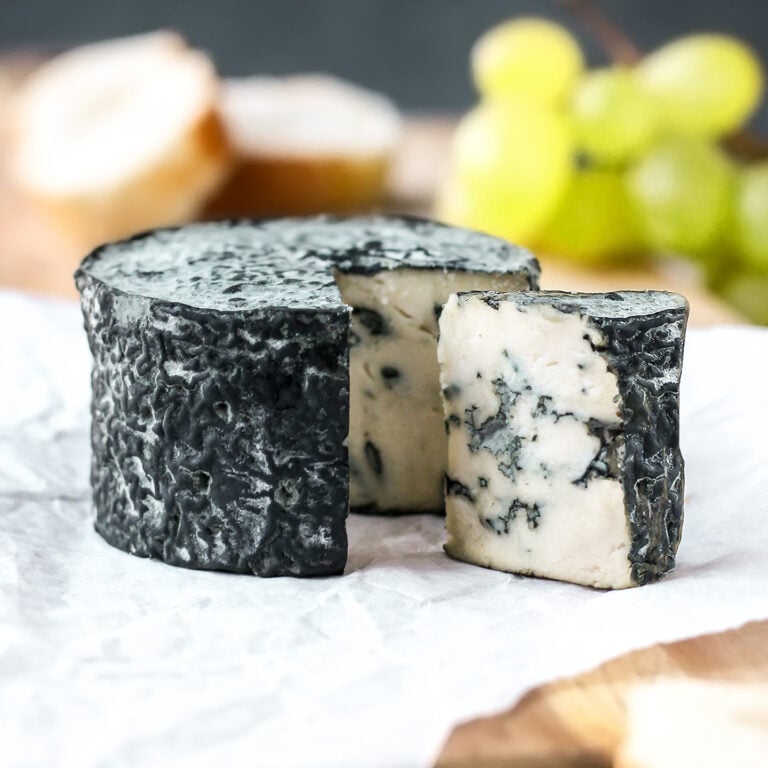
Vegan Blue Cheese
Equipment
Ingredients
- 3 cups (450 g) raw cashews
- 2 tbsp (30 ml) refined coconut oil optional
- 5 tbsp (75 ml) filtered water
- 1/8 tsp mesophilic culture or 6 capsules vegan probiotics (Acidophilus)
- 1/8 tsp penicillium roqueforti in powdered or liquid form
- sea salt
Instructions
The day before
- Start by soaking the cashews in water for at least 5 hours or preferably overnight.
1. Prepare the cashew cream
- Kill bacteria. Drain the cashews and place them in a large glass bowl. Bring a large pot of water to a boil. Once boiling, pour the water directly onto the cashews. Let sit for 1-2 minutes, and drain the cashews again. This step will help kill possible bacteria and prevent bad mold from growing. After draining, allow the cashews to cool down for about 30 minutes.
- Blend into a cream. Transfer the cashews to the bowl of a high-speed blender or food processor. Add the coconut oil and 5 tablespoons of filtered water. Blend on high speed, scraping down the sides from time to time until it forms a smooth and thick cream. This step might take about 10 minutes, depending on your blender.
- Add the cultures. If using Acidophilus, open the probiotic capsules and add the powder to the blender. Otherwise, add the mesophilic powder to the blender. Next, add the Penicillium Roqueforti and blend for another 10-15 seconds.Note: The cashew cream should be smooth but quite thick. If needed, add 1 tablespoon of water at a time until smooth. Do not add too much water, otherwise the mixture will be too liquid.
- Transfer to a bowl. Transfer the cashew cream to a clean bowl and cover it with plastic film, touching the top of the cashew cream (this will prevent the top from drying). Let sit at room temperature in a dark place for about 24h-48h. This step will kick start the fermentation process, giving the cheese its tangy flavor.
2. Shape the cheeses
- Refrigerate the cashew cream. Place the bowl containing the cashew cream in the refrigerator for about 4 hours. This will make the mixture easier to work with.
- Prepare a container. Line the bottom of a food storage container with parchment paper. I use a 12×8 inches (30x20cm) one but any container with a similar size will work. This type of container, for example, works great.
- Line pastry rings. Place four 3×1.75 inches (7.5×4.5cm) pastry rings inside the container. Cut strips of parchment paper measuring 9.5×1.75 inches (24×4.5cm) and arrange them inside the pastry rings to cover the inside sides. Alternatively, you can use plastic film if you prefer. The goal is to prevent the cashew cream from touching the metal.
- Shape the cheeses. Fill each pastry ring to the top with the cashew mixture. Cover the tops with plastic wrap.
- Refrigerate. Close the container and transfer it to the refrigerator. Refrigerate overnight.
3. Salt the cheeses
- The next day, it’s time to remove the cheeses from the pans and salt them. Salt will help with mold growth, so it’s essential.
- Sprinkle salt. The next day, remove the container from the refrigerator. Remove the plastic wrap from the top of the wheels. Sprinkle about 1/4 teaspoon of salt over the top of each wheel. Lightly rub the salt with clean hands to distribute it evenly.
- Flip the wheels. Carefully flip the wheels using a small plate lined with parchment paper. Transfer the wheels back to the container, non-salted side up. Sprinkle another 1/4 teaspoon of salt over the other side of the wheels. Rub some salt on the sides of each wheel as well. Note: The cheeses will still be very soft. This is normal. In a few days, they will firm up and be easier to work with.
4. Age the cheeses
- Refrigerate. Close the container and transfer it to the refrigerator or to a room or cheese cave with a temperature of about 47-52°F (8-11°C). Note: You can age your cheeses at a slightly colder temperature, but the mold will take longer to grow.
- Flip. Every day, carefully flip the cheeses. I recommend using very clean hands or working with gloves (or plastic wrap) to make sure you are not touching the cheeses.
- See the blue mold grow. After 7-10 days, you should start to see some light blue/green mold spots – it’s a good sign! Continue the flipping process for another 7 days. Remember that the mold will be slightly darker or lighter depending on the humidity and temperature of your fridge.
5. Crumble and re-shape
- After a total of 14 days, your cheeses should be a bit firmer and almost completely covered with blue mold! It’s now time to crumble them to create the veins.
- Scramble the cheeses. Using disposable gloves or very clean hands, scramble your cheeses (just like when you scramble tofu) into little pieces of about 1 inch (2.5cm) and transfer them to a clean bowl. The cashew mixture will still be quite soft, it’s normal.
- Re-shape them. Just like you did the first time, place four pastry rings inside a container and line them with parchment paper. Next, fill each pastry ring with the scrambled cheese without pressing too much to leave large holes on the inside. This step is essential to create a nice veining inside the cheese as the mold needs to be in contact with air to grow. You can remove the pastry rings right after shaping the wheels. Place the container back in your refrigerator or aging room.
- Flip. Continue to flip the cheeses every day for the next 3 weeks, always using clean hands or gloves. That’s fine if you miss a day or two.
- Wrap the cheeses. After a total of 5 weeks, the inside and the outside of your cheeses will be covered with blue mold. They will be ready to eat soon! Wrap each cheese in cheese paper or aluminum foil and wait another 3-7 days. The longer you let them age in the refrigerator, the stronger the taste!
- You can store this cheese for about 1 month in the refrigerator. It will become firmer and sharper.
Notes
Age the cheeses in a container during the whole aging process.
Mold needs humidity to grow. That’s why you need to keep the cheeses in a small box or container in your refrigerator. If you were to let the cheeses uncovered, they would dry out before the mold gets a chance to grow.Do not omit any ingredient.
This recipe is not versatile, so I do not recommend substituting or omitting any ingredient.Use disposable gloves.
By using gloves each time you handle the cheeses, you reduce your chances of seeing bad mold growing. Disposable gloves are pretty cheap and come in large boxes, so do not hesitate to get yourself a box.If you are making vegan camembert at the same time:
I recommend you keep them in two separate boxes. Mold can transfer very easily, and you could end up with white mold on your blue cheese or blue mold on your camembert.Regarding the appearance of the cheese.
The rind of this blue cheese is dark blue because I didn’t scrape the sides. Be aware the rind is edible, but if you prefer the exterior to be white, you can gently scrape the mold using a clean knife every two weeks. I prefer to leave the rind because it looks cooler, and after about a month, it will become a little bit firmer. Creamy inside + firm rind = perfect cheese to me.Nutrition

About the Author
Thomas Pagot is the founder, photographer, and recipe developer behind Full of Plants. He created the blog in 2016 as a personal cookbook for vegan recipes. Through years of recipe development, Thomas has successfully grown Full of Plants into a trusted resource for plant-based recipes.

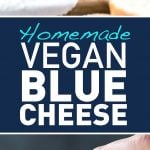
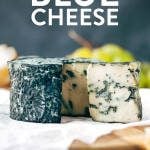



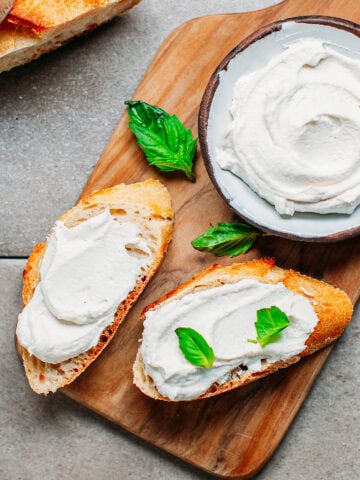
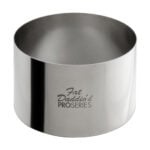
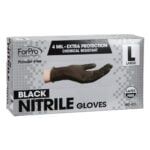
Leave a Comment
Hi, I tried the recipe for the second time and got pinkish mold both times (I also did the camambert this time), do I really have to throw them out ? Can’t I scrap the mold ?
I don’t understand what went wrong, I poured boiling water on everything I used, I use gloves when turning them, etc… Though I didn’t use the probiotic brand you advised, could that be why ?
Otherwise do you have any idea what I am doing wrong ?
Thank you !
Hi Mélody,
If there are just a few spots of pink mold and your cheese doesn’t have a weird or ammonia smell, then yes, you can scrape the mold off and re-salt those spots.
I would suggest cleaning entirely your fridge with diluted vinegar, that could help. I doubt the issue comes from your probiotics but it might be worth testing another brand as well, just to make sure.
Just to clarify, you aren’t using Himalayan salt, right? Some readers have previously mistaken the pink spots it can produce for mold.
Hope this helps!
hi Thomas, i’m finally making some blue cheese! i’m half way, my cheese is almost fully covered with mold and in a few days i’ll scramble it.
my mold is greenish/grey with some speckles of white and dark blue/green. is kinda powdery thought, is it a problem?
the smell is really pleasant and not too sharp.
i’m aging it at the bottom of the frigde in a food container closed with a lid
Hi Ari,
What you describe seems pretty normal. The green/grey mold can appear a bit powdery and may show some spot of white mold as well sometimes. As long as it has a nice smell and doesn’t show pink/orange or black mold, you should be okay! Keep me updated when your cheese is done, I would love to hear your thoughts about it 🙂
Thank you Thomas, yep I’ll surely keep you updated!
ps I tried to uplaod a photo but in the end I didn’t succed, I don’t know if it’s a browser issue or what else…
You’re welcome! Yes, we have removed the feature to upload a photo for the moment.
Hi Thomas! Thank you so much for the recipe, I made my first batch and it’s oustandingly good!
I have a question regarding aging the cheese after the total of 5 weeks. Since I am aware that the mould spreads pretty easily, how would you recommend ageing the cheese in the fridge? If I keep wrapped in parchment paper, do you think that the mould would spread onto other cheeses (I have it in a fridge where I only have cheeses, but some of them are not in a container)? Or is it better to keep it in a container/foil?
Thank you so much!!
Hi Ilaria,
You are welcome! I’m happy to hear you had success with it and enjoyed the cheeses!
There are high chances the mold will spread to other cheeses. Keeping them wrapped and then placing them in a container will help prevent the mold from spreading to other cheeses (although it’s not 100% guaranteed).
Ok got it, thank you so much!
Hi Thomas,
The cheeses are sweating 24 hours after I started aging them. Is that normal? I removed the liquid that was making the base of the cheeses wet using a kitchen paper.
Hi Jose,
Yes that is totally normal. The salt will draw out excess water from the cheeses. Check the cheeses everyday and simply use a kitchen paper to remove any liquid or condensation inside the container. After a few days, you should see less water.
Great! I was a bit worried. Thank you!
Hi Thomas! I’m already following this recipe. Thank you! My question is about the step where you say we should put the mixture in a glass bowl and let it ferment for 24-48 hours with plastic film over it, touching it to prevent it from drying out. Can I use a airtight container instead?
Hi Jose,
An airtight container should work too but you might see a thin crust forming on top of your cashew cream.
I am confused. In the recipe for vegan blue cheese it says to use penicillin candidum but then in two spots it says to use penicillin roqueforti. Which is it?
Thanks so much for the heads up Linda! You are correct, there was a mistake inside the post. It’s penicillium roqueforti.
This is amazing, I had no idea this could be done. You may have just made it easier for me to change more of my diet to a better one. Ty so much
Thanks, you’re welcome Karris!
Is the coconut oil absolutely necessary? I’m trying to avoid it because of the high content of saturated fat. But I understand it would help with texture.
As explained in the ingredient notes, coconut oil is not absolutely necessary. You can simply omit it.
Hi! I wonder if i made this cheese and left some to use it as roqueforti culture in another batch, would it work?
Hi Yasemin,
Yes, that should work!
Merci pour cette recette, je viens de commander le matériel nécessaire pour le Bleu et j’ai hâte de me lancer.
J’ai une question concernant davantage le camenbert, dans la mesure où le lait de soja coagule, n’est il pas possible de partir sur cette base comme un vrai camenbert ?
D’autre part, connaissez vous le Neufchâtel, un autre fromage Normand, dans le cas positif, envisagez vous de le veganiser ?
J’ai une autre question, l’utilisation de sel d’himalaya est il utilisable pour faire ces fromages ?
Effectivement le lait de soja coagule, ce qui donne du tofu. Le tofu n’est pas assez riche en gras pour donner une texture satisfaisante. Les noix de cajou, au contraire, son grasses ce qui permet d’obtenir une texture riche et fondante 🙂
En ce qui concerne le Neufchâtel, je ne connais que de nom et je n’ai malheureusement jamais eu l’occasion d’y goûter.
Je vous déconseille d’utiliser du sel d’Himalaya car il vous sera difficile de savoir par la suite si vous avez de la moisissure rose ou si c’est seulement les grains de sel.
Thomas, I am about to begin my first batch & I can’t tell you how excited I am! I do have a question that I am not aware of having been addressed in the comments. As you no doubt know some traditional dairy-based blues are pierced through with needles or rods to allow for aeration & mold development. Do you know if this would work as an alternative to the crumble & repacking method outlined here?
Hi Adeline,
I actually tried to pierce the cheeses with spikes/chopsticks and while it does work, I was not fully satisfied with it. The veining doesn’t look as nice and because of that, the taste is also milder.
Dear Thomas,
this summer I have been to Paris and have tried my first vegan blue cheese there (Jay&Joy) and directly fell in love with it. Since I just live in a rural area and don’t want to order the cheese always (also its quite pricy), I decided to start making my own and stumbled upon your recipe. So first thanks a lot for this recipe! 🙂
On my first time, I have produced enough mixture, to make two cheeses out of it. Therefore I tried both approaches, so with one I just poked holes in it, and with the other one, I crumbled and put it back together once it was Filly covered in mold.
With the one that had holes in it, I couldnt wait longer than 4 weeks, because it looked so nice from the outside. It also had nice blue veins in it, but the taste was rather mild… like camembert.
With the other one, that I crumbled, I just tried it this weekend. Its been 6 weeks since the day I have produced the initial cashew mixture.
It definetly smells and tastes more spicy/piquant and has a more cheesy flavour. However these days I’ve had the chance to try another vegan blue cheese from the store (Nutty). Similiar to the cheese from Jay&Joy, the one from Nutty has more blue cheese smell and flavour.
What could it be that I am doing wrong ? Is it maybe the wrong strain of rocqueforti?
Also with these first two cheeses, I didnt add coconut oil, could that be the reason? Or is it maybe because of the temperture? I’ve read that some people put the cheese to lower temperatures (2-4°C), once it has mold all around it. Also I didnt put it into aluminium foil, I basically kept it in the same ripening box at the same frige compartment (thats between 10-12°C) fir those 6 weeks.
Have you tried the “Jay&Joy” or “Nutty” and know their exact flavours ? Alternatively, I was thinking to take a teaspoon of the “Nutty” cheese as a starter for my next mixture.
Hi Alex,
I haven’t tried the Nutty brand but it looks like they used this exact recipe as a base as it seems they crumbled the mixture (and also use coconut oil). I did try Jay & Joy and I think instead of crumbling they just slice the cheese and then layer it to create horizontal veins.
Regarding the taste of your cheese, it mostly comes down to 3 things that you already mentionned in your comment:
1. The strain of penicillium roqueforti: Depending on the type and the brand of your penicillium roqueforti you will get different results. One more thing to note is that those brands may also use other cultures such as Geotrichum Candidum (for a stronger, cheesier aroma) and/or Flora Danica, which will add a more buttery taste. I would suggest experimenting with these too. Personally, I almost always add a pinch of Flora Danica for more complex flavors.
2. The aging temperature: A colder temperature will yield a blue mold with a brighter color and a cheese with a lighter flavor. A warmer aging temperature will give you a stronger cheese with a very dark (almost black) blue mold.
3. The aging time: You mention you didn’t wrap the cheeses. I would recommend wrapping them with cheese paper and letting them age for another 1-2 weeks in your refrigerator (at a colder temperature) to allow the flavors to develop.
I hope this helps!
I definetly agree, the Nutty brand uses the crumbling method, also saw this on their Insta page!
Regarding:
1) Is the one that you have linked in your recipe or do you know in general a brand or the name of the roqueforti strain that tastes similiar to the Jay & Joy one ? Mesophilic cultures I have definetly used, is there a difference to Flora Danica? I checked out the one I bought and some Flora Danica I found in the internet and they seem to have the same cultures in them… Geotrichum Candidum I haven’t tried out, but that also sounds like I should give it a try ! 🙂
2)/3) Ok I will also give it a try with the cheese paper! I don’t fully understand though what you mean by „to allow flavors to develop“ and „warmer aging temperatures give stronger cheese“. What exactly do you mean with „stronger cheese“ and „flavors to develop“? Would that be different flavors in your opinion, so that the „wrapping in cheesepaper and putting it at colder temperatures (e.g 5 degrees celsius)“ might result in the flavors I am looking for, while leaving it unwrapped in the riping box at around 11 degrees, would make it only more piquant and spicy ?
But like I said, I‘ll definitely give it a try with the cheesepaper 🙂 Actually, I guess I’ll use half the cheese I have atm and do a little experiment to actually taste and smell the difference when I wrap it in cheesepaper and put it colder compared to when I leave it in the ripening box at warmer temperatures.
Thanks again for your answer and taking the time to respond. It’s really nice that you share all of this informations/recipes and even take the time to answer all people in the comments! I hope I can achieve the taste and flavor someday, then I can finally show it to one of my old friends, that I couldn’t convince with vegan cheese so far 😀
Also thought I’ll share some pictures to show everyone how nice this recipe works 🙂
I’m afraid I do not know what strain they use, and I personally don’t always use the same strain/brand depending on the availability of it in the store.
Regarding Flora Danica, it’s an aromatic culture that actually consists of different strains of mesophilic cultures. I really believe it’s worth giving it a try as I always got richer, more buttery cheeses when using it. Geotrichum candidum will give you a stronger cheese, a bit closer to goat cheese.
Aging temperature: I mean by that, that if your fridge is set at higher temperature, it will result in a stronger, more piquant cheese. On the opposite, a colder temperature typically results in a milder blue cheese. Regarding wrapping: After crumbling, reshaping, and aging again, I recommend wrapping your blue cheeses in cheese paper and placing them in a fridge set at a colder temperature (for example 4-5°C). After a week, your cheeses will taste different as they will have developed more complex flavors.
Thanks for sharing your photos, your cheeses look good! Great job Alex 😉
Dear Thomas and everyone else who might be reading this,
just thought, I’ll share my pogress. So I produced another blue cheese by taking a slice of the Nutty cheese and shortly mixing it with the cashew cream at the beginning of the process.
What can I say, it now tastes excactly the way I want, so I think it definetly must have been the strain of the cultures. Compared to the one I initially used, I didn’t do anything different. Now I have a nice taste that goes into the direction of “Gorgonzola” or even a bit stronger. I feel like an expert now that I know there are different strains of rocqueforti 👻
So if anyone stumbles upon this and has the same issue… I bought the cultures from a German website called “kaese-selber.de”. Their cultures rather resulted in a very mild Gorgonzola taste over the whole aging process. I had that cheese age up to 8 weeks and at the end it became also really flavorsome, but only remained subtle “Gorgonzola” tastes. Hard to describe though what cow-cheese it was similiar to, since I didn’t have any blue cheeses for a long time… So yeah…
Thanks again Thomas for all the effort and the answers you gave me, have a good one 😊
Hi Alex,
That’s awesome! I’m really happy for you that you finally reached the taste you were after 🙂
And yes, a lot of parameters can affect the flavor (strains of penicillium roqueforti, aromatic cultures, temperature, humidity, etc). Anyway, thanks for reporting back on your experiments, I appreciate it and I’m glad I could help a bit!
I’m working on this blue cheese, I’m at day 5, but I have the cheeses individually wrapped in plastic wrap, will that be okay or should I have them in a pan covered and not wrapped? Thanks for any helpful hints!
Hi Kim,
After salting, the cheeses shouldn’t be wrapped at all. Just keep them in a container or on plate covered with an upside down container to keep enough moisture.
Hi, Would it be possible for you to make a video for this recipe? It looks great! I have not made it yet, but it is worth to try for sure.
Hi Kathy,
I’ll try to make a video next time I make another batch!
What happens if the mixture seems a bit runny?
It means you probably added too much water when blending. If it’s not too liquid, you can still follow the next steps. The salting step should make your wheels a bit firmer as it will extract some water. Next time, start with less water when blending the cashews.
Also, please only rate a recipe after you have fully tested it 😉
I accidentally came across your recipe and decided to try to implement it. But I have a problem – I can’t stand coconut oil at all. Is it possible to replace it with the same amount of olive oil or corn oil? Or at least for a solid butter like cocoa or shea butter?
Hi Alex,
You can simply omit it or use another oil such as shea butter or deodorized cocoa butter.
Dear Tomas,
the blue cheese looks great.
Do the blue cheese can be done with almond vegan cheese, instead cashews?
Hi Ayala,
I didn’t have any success with almonds, sorry. The texture was off and not as smooth.
I can’t eat coconut; can this cheese still be made without it? Can avocado oil replace it?
You can simply omit the coconut oil or use shea butter 😉
I’m not a vegan, I just want to eat healthier. I read one of the comments about using “real blue cheese” as a starter. How much should I use? A couple of tablespoons? Would using a lot more make the process faster? Say, half a real Roquefort? I plan on making the cheese, and then reusing some leftovers for the next batch (like making kombucha). Once I reuse the cheese from your recipe using the non-vegan cheese as a starter, how much to add to the next batch? I’m hoping it will become more vegan after a few batches if I want to share it with my vegan sister. Thanks for the hard work!
I’m afraid using more starter won’t make the process faster. A couple of tablespoons should be more than enough to replace the powdered penicillium roqueforti. Blend that with the cashew cream and age the cheeses as written in the recipe, it will work the same.
It will work the same for your next batch, use a couple of tablespoons of the previous blue cheese. I wish you good luck with your vegan cheese experiments!
download vegan cheese making is not working, can you sent it
I’m sorry, we recently removed the ebook from the blog as a freebie. It has been available for free for more than 5 years and unfortunately has been stolen multiple times and then sold on other platforms. We don’t even have enough time to fill all of the copyright infringement reports. Hence, we have decided to remove it from the blog for now.
We are going to update it, rework it, and sell it by ourselves as an ebook (and probably hardcover as well) soon on the blog. Since it will be a paid book, it will also make it easier for us to submit copyright removal requests in the future.
Thank you so much for this recipe Thomas! I was wondering if over the years you have tried this cheese with almonds or sunflower seeds instead of cashews 🙂
I’m afraid I haven’t tried using sunflower seeds, sorry. I tested with raw blanched almonds in the past but was not happy with the texture as it was not as smooth and rich as cheeses made with cashews.
Taste and texture and brilliant! Thanks so much for enriching my life!
Your blue cheeses look perfect! Great job and thanks for sharing a photo, I love to see your results!
Just made two of these cheeses, following your recipe and… they are brilliant! Taste and texture are awesome. You’ve changed my life. Thank you!
Thank you so much for your rating and feedback Roy!
Thank you! I didn’t think I would ever be able to enjoy blue cheese again, being dairy free. This cheese is the real deal. So good! This was my first time making this cheese and I look forward to making it again!
Thank you so much for your great feedback Alanna 😉
Hi, it’s been 9 days but all I see is a bit of white fluffy mould and no blue. Does that mean it’s likely contaminated? The penicilllum is in liquid form, do you think I could a add a drop and maybe it takes hold?thanks
Hi Olivia,
You need to be patient, mold can take longer than 10 days to grow depending on the temperature. If you are aging your cheeses at a colder temperature, the mold will take longer to develop. There is no need to add extra penicillium.
Hi Thomas,
I have the same problem as Olivia with white fluffy mold appearing. Is this considered normal and not bad mold?
Hi Isabelle,
If it looks like small dots of white mold, you should scrape it off and resalt the area. White mold is not necessarily bad mold but you don’t want it to spread on your blue cheese.
NOT VEGAN:
Penicillium Roqueforti. Sufficient for 200 gallons of milk. Approximately 1/4 tsp of culture or about .3 grams. Not vegan. It is propagated on a lactose base containing gluten
Thanks for your heads up Christopher, but I would recommend checking the disclaimer in the article about that where we explain it all.
Hi, currently the penicillium roqueforti link is going to a Rodent Repellent Spray, could you update? Not sure which to choose if I just do a search. Thank you!
Hi Kirsi,
It has been fixed!
Thank you for sharing. I’ll try it soon. It’s amazing.
Please check your links! It takes you to anti rat spray. Yup plant based but still odd.
Thanks for the heads up! Well, at least it was plant-based 😉
More seriously, it can happen that Amazon will keep an URL but change the product on that URL. We fixed it.
This cheese looks amazing!
Too bad I can’t consume coconut oil. My cholesterol skyrockets when I have added it to my diet, even in small amounts. Have you tried anything like avocado oil or olive oil? Brazil nuts seem to be very high in fat. I wonder if they could be used in addition?
Thanks Thérèse! Some readers had success making this blue cheese without the use of coconut oil, so you might try that!